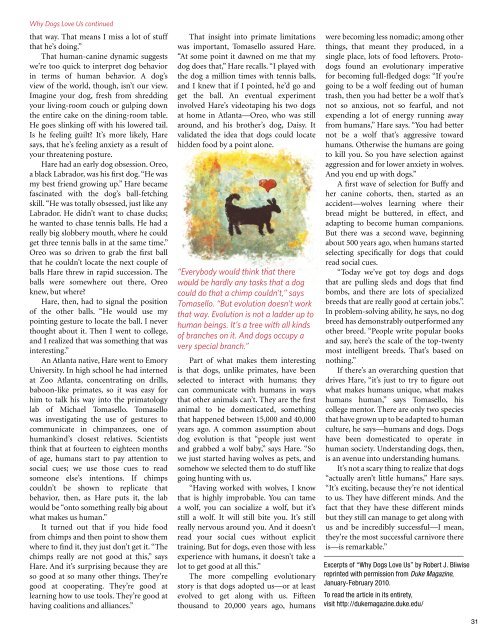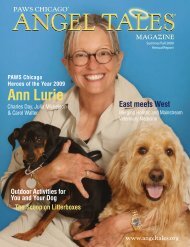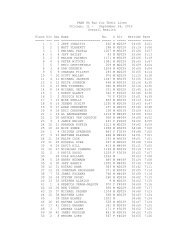Summer 2010 - PAWS Chicago
Summer 2010 - PAWS Chicago
Summer 2010 - PAWS Chicago
Create successful ePaper yourself
Turn your PDF publications into a flip-book with our unique Google optimized e-Paper software.
Why Dogs Love Us continuedthat way. That means I miss a lot of stuffthat he’s doing.”That human-canine dynamic suggestswe’re too quick to interpret dog behaviorin terms of human behavior. A dog’sview of the world, though, isn’t our view.Imagine your dog, fresh from shreddingyour living-room couch or gulping downthe entire cake on the dining-room table.He goes slinking off with his lowered tail.Is he feeling guilt? It’s more likely, Haresays, that he’s feeling anxiety as a result ofyour threatening posture.Hare had an early dog obsession. Oreo,a black Labrador, was his first dog. “He wasmy best friend growing up.” Hare becamefascinated with the dog’s ball-fetchingskill. “He was totally obsessed, just like anyLabrador. He didn’t want to chase ducks;he wanted to chase tennis balls. He had areally big slobbery mouth, where he couldget three tennis balls in at the same time.”Oreo was so driven to grab the first ballthat he couldn’t locate the next couple ofballs Hare threw in rapid succession. Theballs were somewhere out there, Oreoknew, but where?Hare, then, had to signal the positionof the other balls. “He would use mypointing gesture to locate the ball. I neverthought about it. Then I went to college,and I realized that was something that wasinteresting.”An Atlanta native, Hare went to EmoryUniversity. In high school he had internedat Zoo Atlanta, concentrating on drills,baboon-like primates, so it was easy forhim to talk his way into the primatologylab of Michael Tomasello. Tomasellowas investigating the use of gestures tocommunicate in chimpanzees, one ofhumankind’s closest relatives. Scientiststhink that at fourteen to eighteen monthsof age, humans start to pay attention tosocial cues; we use those cues to readsomeone else’s intentions. If chimpscouldn’t be shown to replicate thatbehavior, then, as Hare puts it, the labwould be “onto something really big aboutwhat makes us human.”It turned out that if you hide foodfrom chimps and then point to show themwhere to find it, they just don’t get it. “Thechimps really are not good at this,” saysHare. And it’s surprising because they areso good at so many other things. They’regood at cooperating. They’re good atlearning how to use tools. They’re good athaving coalitions and alliances.”That insight into primate limitationswas important, Tomasello assured Hare.“At some point it dawned on me that mydog does that,” Hare recalls. “I played withthe dog a million times with tennis balls,and I knew that if I pointed, he’d go andget the ball. An eventual experimentinvolved Hare’s videotaping his two dogsat home in Atlanta—Oreo, who was stillaround, and his brother’s dog, Daisy. Itvalidated the idea that dogs could locatehidden food by a point alone.“Everybody would think that therewould be hardly any tasks that a dogcould do that a chimp couldn’t,” saysTomasello. “But evolution doesn’t workthat way. Evolution is not a ladder up tohuman beings. It’s a tree with all kindsof branches on it. And dogs occupy avery special branch.”Part of what makes them interestingis that dogs, unlike primates, have beenselected to interact with humans; theycan communicate with humans in waysthat other animals can’t. They are the firstanimal to be domesticated, somethingthat happened between 15,000 and 40,000years ago. A common assumption aboutdog evolution is that “people just wentand grabbed a wolf baby,” says Hare. “Sowe just started having wolves as pets, andsomehow we selected them to do stuff likegoing hunting with us.“Having worked with wolves, I knowthat is highly improbable. You can tamea wolf, you can socialize a wolf, but it’sstill a wolf. It will still bite you. It’s stillreally nervous around you. And it doesn’tread your social cues without explicittraining. But for dogs, even those with lessexperience with humans, it doesn’t take alot to get good at all this.”The more compelling evolutionarystory is that dogs adopted us—or at leastevolved to get along with us. Fifteenthousand to 20,000 years ago, humanswere becoming less nomadic; among otherthings, that meant they produced, in asingle place, lots of food leftovers. Protodogsfound an evolutionary imperativefor becoming full-fledged dogs: “If you’regoing to be a wolf feeding out of humantrash, then you had better be a wolf that’snot so anxious, not so fearful, and notexpending a lot of energy running awayfrom humans,” Hare says. “You had betternot be a wolf that’s aggressive towardhumans. Otherwise the humans are goingto kill you. So you have selection againstaggression and for lower anxiety in wolves.And you end up with dogs.”A first wave of selection for Buffy andher canine cohorts, then, started as anaccident—wolves learning where theirbread might be buttered, in effect, andadapting to become human companions.But there was a second wave, beginningabout 500 years ago, when humans startedselecting specifically for dogs that couldread social cues.“Today we’ve got toy dogs and dogsthat are pulling sleds and dogs that findbombs, and there are lots of specializedbreeds that are really good at certain jobs.”.In problem-solving ability, he says, no dogbreed has demonstrably outperformed anyother breed. “People write popular booksand say, here’s the scale of the top-twentymost intelligent breeds. That’s based onnothing.”If there’s an overarching question thatdrives Hare, “it’s just to try to figure outwhat makes humans unique, what makeshumans human,” says Tomasello, hiscollege mentor. There are only two speciesthat have grown up to be adapted to humanculture, he says—humans and dogs. Dogshave been domesticated to operate inhuman society. Understanding dogs, then,is an avenue into understanding humans.It’s not a scary thing to realize that dogs“actually aren’t little humans,” Hare says.“It’s exciting, because they’re not identicalto us. They have different minds. And thefact that they have these different mindsbut they still can manage to get along withus and be incredibly successful—I mean,they’re the most successful carnivore thereis—is remarkable.”Excerpts of “Why Dogs Love Us” by Robert J. Bliwisereprinted with permission from Duke Magazine,January-February <strong>2010</strong>.To read the article in its entirety,visit http://dukemagazine.duke.edu/31
















